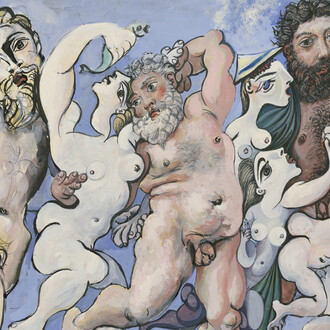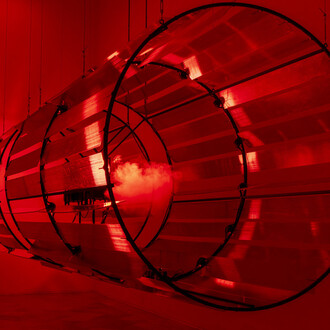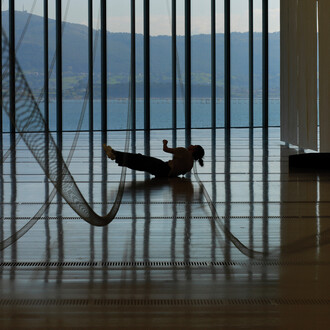Casado Santapau is pleased to present En fin, el mar, the fourth solo exhibition by cuban artist Diango Hernández (1970).
Diango Hernández presents a new body of work that expands his rigorous practice—meticulous, restrained, and silently charged, always in constant evolution. The exhibition brings together two acrylic-on-canvas paintings, where light curved lines unfold over dark backgrounds, alongside a group of pieces that revisit the motif of the wave as a minimal unit of meaning. In these latter works, he introduces subtle changes: diptychs, irregular canvases, and metal components that bring new tension to his precisely modulated surfaces, bordering on geometry. Each composition resists interpretation; instead, it pulses with ambiguity, depth, and spatial complexity.
In this body of work, the Cuban artist based in Düsseldorf continues developing what he has termed Olaísmo (Waivism)—not an artistic movement nor a manifesto, but a way of being in painting—and perhaps also in the world—that privileges rhythm, cadence, and return over affirmation or narrative construction. Hernández’s waves do not refer to an image of the sea, but to an internal logic: a way of thinking through a simple, repeated gesture. What is seen is a curve. What is perceived is time—a suspended memory.
En fin, el mar can be read as a conclusion, a surrender, or a yielding to something that cannot be defined. It is not so much a geographic place as a symbolic horizon: a space of dissolution of form, of openness to the infinite, of memory and desire. In this sense, the sea is not depicted, but is present—as an idea, an atmosphere, a latency. The works invite slow, almost meditative contemplation that escapes the logic of spectacle and proposes a quieter, more engaged relationship with seeing.
The economy of means—minimal lines, silent backgrounds, total absence of figures—does not imply coldness or distance. On the contrary, each line, each form, seems to contain an internal tension, an emotional vibration that is transmitted through simplicity. The curves are not static forms; they are frozen movements, records of a gesture repeated and refined until it becomes a symbol. In their apparent neutrality, the works establish a profound closeness with the viewer, not through identification, but through resonance.
There echoes what Aby Warburg called pathosformeln—visual configurations capable of surviving through time and reappearing in different contexts as carriers of affective intensity. Hernández’s waves can be read in this key, not as decorative or abstract motifs, but as forms charged with energy, as fragments of emotion transformed into visual language. His painting does not narrate, but it affects; it does not represent, but it endures.
En fin, el mar thus unfolds as a spatial and temporal experience, in which each work functions as a distinct modulation of a single score. There is no climax or resolution, only a serene insistence on the essential. In the curve, in the black, in the repetition, Hernández finds not an answer, but a way of being. And in that being, he returns us to the most basic elements of painting: a gesture, a rhythm, a surface—and behind all of that, an unending emotion, like the sea.











![Saul Steinberg, The museum [El museo] (detalle), 1972. Cortesía del Museo de Arte Abstracto Español](http://media.meer.com/attachments/dfbad16c22c5940b5ce7463468ac8879f3b4bf23/store/fill/330/330/042ecf3bcd2c9b4db7ddbc57cb32e950c095835f7b5cd55b6e1576a6e78c/Saul-Steinberg-The-museum-El-museo-detalle-1972-Cortesia-del-Museo-de-Arte-Abstracto-Espanol.jpg)


